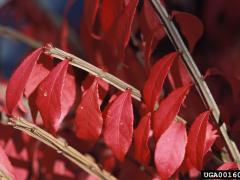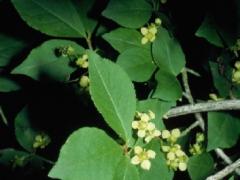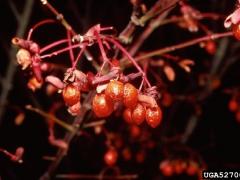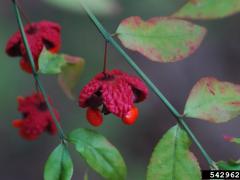Invasive Species: Euonymus alatus, Winged Burning Bush
Winged burning bush is an invasive deciduous shrub, up to 20 ft (6.1 m) in height, which invades forests throughout the Eastern United States. Occasionally, four corky ridges appear along the length of young stems. The opposite, dark green leaves are less than 2 in. (5 cm) long, smooth, and rounded and taper at the tips. The leaves turn a bright crimson to purplish color in the fall. The inconspicuous flowers are greenish yellow and have four petals. Flowers develop in the spring and lie flat against the leaves. Fruit are reddish capsules that split to reveal orange, fleshy seeds. Winged burning bush can invade a variety of disturbed habitats, including forest edges, old fields, and roadsides. Birds readily disperse the seeds, allowing for many long dispersal events. Once established, the plant can form dense thickets that displace native vegetation. Winged burning bush is native to northeastern Asia and was introduced in North America in the 1860s for ornamental purposes. Currently, it is sold and planted as an ornamental plant or roadside hedge.
What are invasive species, and why should we be concerned about them?
Taxonomy: Scientific and Common Names for This Species
Celastrales > Celastraceae > Euonymus alatus (Thunb.) Sieb.
Synonym(s): burning bush, winged euonymus, winged spindle tree
Euonymus alatus – USDA PLANTS Profile
Distribution Maps
winged burning bush – The reported distribution of this invasive species across the United States (Source: Invasive Plant Atlas of the United States)
Up-to-the-minute distribution maps and why they are important
Reporting This Invasive Species
What is the best way to report the occurrence of an invasive species?
How to report an invasive species sighting to EDDMapS – Early Detection & Distribution Mapping System
EDDMapS – Report an invasive species to EDDMapS.
County Extension Offices – Find your county Extension office on this map provided by USDA.
How to Identify
This invasive species can be identified by looking for the characteristics described in the paragraphs that follow.
Shrub
Winged burning bush is a deciduous shrub that grows up to 20 ft (6.1 m) in height. Occasionally, four corky ridges appear along the length of young stems.
 |
 |
| Paul Wray, Iowa State University, bugwood.org | Barry Rice, sarracenia.com, bugwood.org |
Foliage
The opposite, dark green leaves are less than 2 in. (5 cm) long, smooth, and rounded and taper at the tips. The leaves turn a bright crimson to purplish color in the fall.
 |
 |
| James H. Miller, USDA Forest Service, bugwood.org | James H. Miller, USDA Forest Service, bugwood.org |
Flower
The inconspicuous flowers are greenish yellow and have four petals. Flowers develop in the spring and lie flat against the leaves.
 |
|
| Leslie J. Mehrhoff, University of Connecticut, bugwood.org | bugwood.org |
Fruit
Fruit are reddish capsules that split to reveal orange, fleshy seeds.
 |
 |
| Leslie J. Mehrhoff, University of Connecticut, bugwood.org | Leslie J. Mehrhoff, University of Connecticut, bugwood.org |
Native Euonymus Species That Resemble Winged Burning Bush
Euonymus americana, strawberry bush – Images at invasive.org
 |
 |
| Karan A. Rawlins, University of Georgia, bugwood.org | Karan A. Rawlins, University of Georgia, bugwood.org |
Euonymus obovatus, running strawberry bush – Images at invasive.org
 |
|
| Joseph O’Brien, USDA Forest Service, bugwood.org | bugwood.org |
Additional Images for Winged Burning Bush
winged burning bush – Images at invasive.org
Learning Resources for Winged Burning Bush
Euonymus alatus Identification Card – U.S. Fish and Wildlife Service
Euonymus alatus Fact Sheet – U.S. Fish and Wildlife Service
Additional Information, Biology, Control and Management Resources
Control and management recommendations vary according to individual circumstances. Location, habitat, weather, and a variety of other conditions are factors that help determine the best treatment choice. To find the safest and most effective treatment for your situation, consult your state’s land-grant institution. If you will use chemicals as part of the control process, always refer to the product label.
United States Land-Grant University System – Find your Land-Grant University’s College of Agriculture, University Cooperative Extension Service, or other related partner on this map provided by USDA.
Fact Sheet – Pennsylvania Department of Conservation and Natural Resources
Nonnative Invasive Plants of Southern Forests – USDA Forest Service
Plant Invaders of Mid-Atlantic Natural Areas – National Park Service and U.S. Fish and Wildlife Service
Invasive Plant Information Sheet – Connecticut Invasive Plant Working Group
Euonymus alatus – Global Invasive Species Database
Element Stewardship Abstract – The Nature Conservancy
Invasive Plant Atlas of New England – University of Connecticut
Weed of the Week – USDA Forest Service
